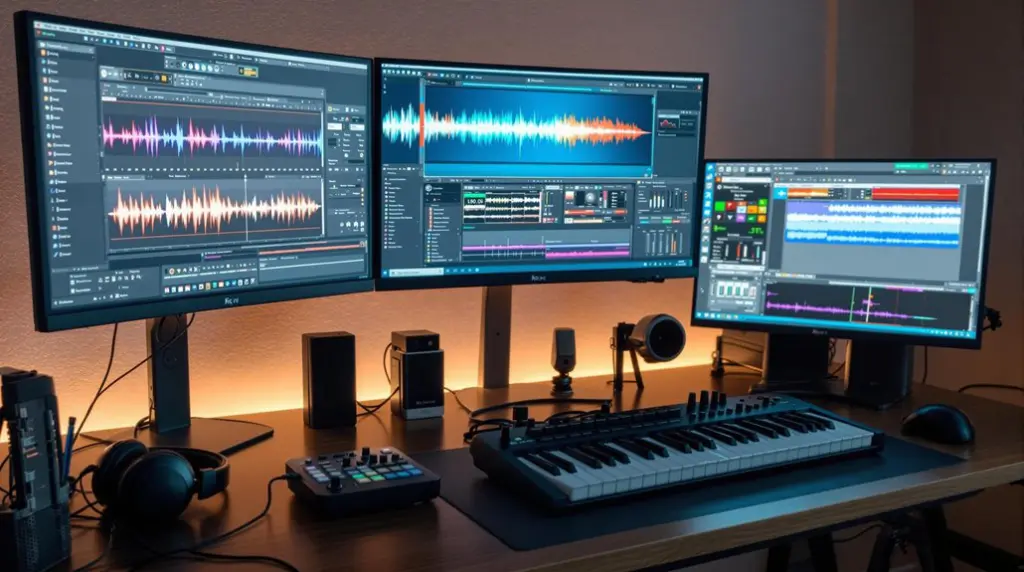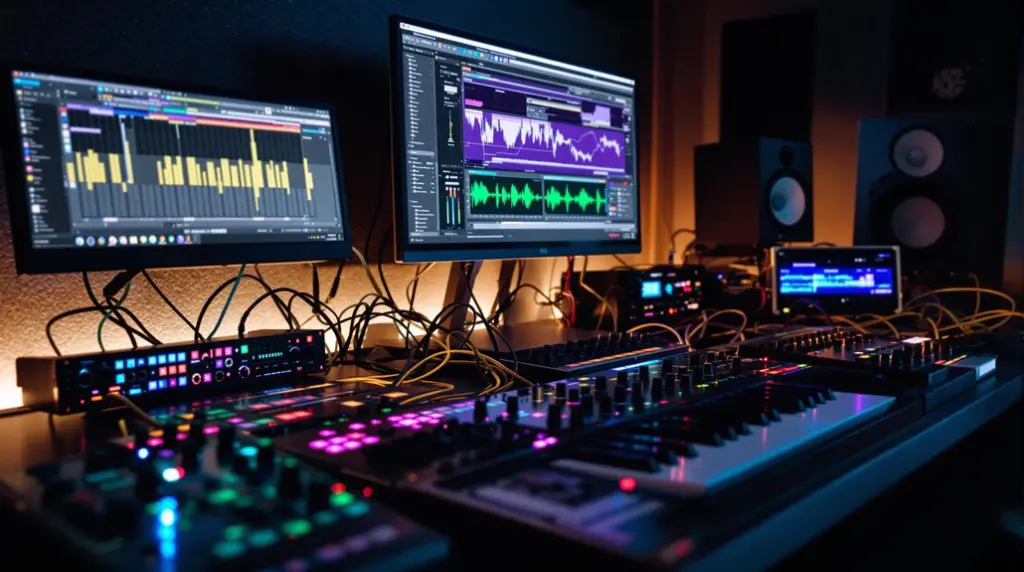The Roland JX-8P synthesizer excels in three main areas that distinguish it from its contemporaries. To begin with, its rich and warm pads, enhanced by integrated chorus effects, provide lush ambient textures ideal for varied soundscapes. In addition, the dual digitally controlled oscillators (DCOs) per voice offer versatile sound shaping with waveform options like sawtooth, pulse, and square. Finally, its extensive MIDI capabilities position it as a competent master keyboard, essential for modern setups. While there are concerns about its complex programming and durability, its features make it a sound investment for serious musicians looking for depth and quality. Discover more nuanced insights ahead.
Key Takeaways
- Warm Pads and Lush Chorus: Celebrated for its warm pads and lush onboard chorus effects, enhancing rich ambient textures.
- Dual DCOs per Voice: Features two digitally controlled oscillators per voice, offering diverse waveform options for versatile sound crafting.
- Six-Voice Polyphony: Six voices of polyphony enable complex layering and rich sound textures.
- Extensive MIDI Capabilities: Functions as a master keyboard with extensive MIDI capabilities.
- Built-In Chorus Effect: The built-in chorus effect adds significant depth and warmth to the overall sound quality.
Sound Quality
Explore the sonic domain of the Roland JX-8P, and you will find a synthesizer celebrated for its warm pads, lush chorus effects, and rich ambient textures. At the heart of its sound quality are the two digitally controlled oscillators (DCOs) per voice, which offer a diverse array of waveforms, including sawtooth, pulse, and square. This setup provides significant pad versatility, allowing musicians to craft a wide range of sounds from delicate, ethereal textures to robust, full-bodied tones.
Targeted EQ techniques can further enhance these waveforms, especially when boosting mid and high frequencies to add presence. The onboard chorus circuitry, reminiscent of the Juno-106, augments these waveforms by adding a notable depth and richness, making the JX-8P particularly adept at producing lush, enveloping ambient textures.
However, while the JX-8P excels in generating pads and leads, its sound profile can benefit substantially from external effects such as delay and reverb. These additions can boost the synth’s inherent warmth and complexity, providing a more immersive auditory experience.
Despite its prowess in the mid and high registers, the synthesizer’s ability to produce powerful sub-bass tones can be somewhat hampered by noise artifacts at lower frequencies. This limitation should be noted by those seeking pristine bass performance.
User Experience
When it comes to user experience, the Roland JX-8P presents a nuanced blend of strengths and challenges. User satisfaction varies considerably, primarily influenced by the instrument’s heavy key feel and subpar aftertouch functionality, which requires considerable force—often cited in user feedback as a drawback.
Additionally, the complexity of programming without the PG-800 editor can be intimidating, making the dedicated programmer an essential accessory for ideal sound manipulation. This limitation is exacerbated by the JX-8P’s restricted multitimbrality, allowing only 8 user-programmed patches.
Despite these challenges, the PG-800 editor greatly enhances user satisfaction by simplifying sound editing, thereby elevating the overall programming experience. Users also appreciate the JX-8P’s elegant design, though frequent complaints about its size and weight are noted.
Moreover, issues such as key sticking are common but manageable with routine cleaning. However, concerns over the instrument’s long-term durability persist, particularly regarding its plastic endblocks, which are prone to damage.
Technical Features
Balancing its nuanced user experience, the Roland JX-8P stands out with a robust array of technical features that cater to both novice and seasoned musicians. Central to its sonic architecture are the six voices of polyphony, providing ample room for rich sound layering and complex textures without encountering note-stealing issues. Each voice is powered by two digitally controlled oscillators (DCOs), which offer a variety of waveform options including sawtooth, pulse, square, and noise. This diversity in oscillator types guarantees a wide spectrum of sound generation, from lush pads to biting leads.
Moreover, the JX-8P’s connectivity is enhanced by its extensive MIDI capabilities, allowing it to function as a master keyboard while disengaging its internal sounds, which is a significant advantage for any digital audio workstation setup.
The built-in chorus effect is another standout feature, elevating the overall sound quality by adding depth and warmth, making the JX-8P’s output remarkably fatter compared to its contemporaries like the Juno-106. On the connectivity front, the JX-8P’s extensive MIDI capabilities allow it to function as a master keyboard, with the ability to control other MIDI-equipped instruments while disengaging its internal sounds.
However, the synthesizer does have its limitations, particularly in its memory capacity. With only 32 user-programmable locations and 64 non-volatile preset sounds, memory expansion is reliant on an additional RAM cartridge.
Despite this, the JX-8P’s technical prowess makes it a compelling choice for serious musicians.
Frequently Asked Questions
When Did the Roland JX-8P Come Out?
The Roland JX-8P, a significant entry in synth history, was released in June 1985. Its vintage appeal and advanced polysynth capabilities made it a notable competitor in the 1980s synthesizer market, particularly against the Yamaha DX7.
Is the Roland JX 08 Analog?
The Roland JX-08 is not an analog synthesizer; it employs digital synthesis techniques. However, it maintains the analog sound character through advanced modeling, offering versatile sound design capabilities with bi-timbral functionality and 17 built-in multi-effects options.
How Many Voices Is Roland JX 08?
The Roland JX-08 boasts 20 voices of polyphony, offering extensive sound design capabilities. This advanced polyphony option allows for richer, more complex compositions, minimizing note stealing and enhancing performance flexibility in both dual and split modes.
Conclusion
In summation, the Roland JX-8P synthesizer distinguishes itself through its exceptional sound quality, intuitive user interface, and robust technical features. The instrument’s analog warmth, coupled with sophisticated modulation capabilities, renders it a versatile tool for both studio and live performance settings. The user experience is enhanced by thoughtfully designed controls and user-friendly programming options. Its technical specifications, including MIDI implementation and patch memory, make it a reliable and powerful addition to any music production arsenal.




